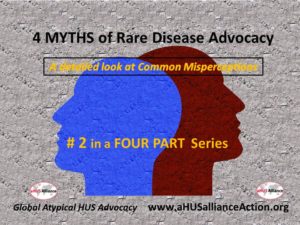
The SECOND Article in a Four Part Series
Rare Disease Advocacy: Digging deeper into Common Misperceptions
Although there are over 7000 rare diseases, rare patient populations affected by each are by definition very small numbers of people. In nations around the world, people living with a rare disease become advocates to help raise awareness, share information, offer insight, provide support, assist research, and promote healthcare policies that make a positive difference. Depending on the situation, people, and groups involved there’s both an art and a science behind effective advocacy and patient engagement in the rare disease arena. At the same time, proactive avoidance of common pitfalls to may help ideas and projects to bypass ‘echo chambers’ that fail to optimize efforts and maximize results.
The term “rare disease” might mislead the general public as an estimated 350 million people are living with one of these rare diseases, with perhaps many more people still undiagnosed or misdiagnosed. Rare disease statistics, definitions, and other information varies around the world. In Europe, a disease or disorder is defined as rare when it affects fewer than 1 in 2000 people while the USA definition is slightly different, defining a disease or disorder as rare when it affect fewer than 200,000 Americans at any given time. (Source – Rare Disease Day: What is a Rare Disease)
4 myths of Rare Disease Advocacy: A detailed look at Common Misperceptions
Second of 4 articles in aHUS Alliance series
The best way for rare disease patients to be an advocate is to share their personal journey and patient experiences.
We agree that telling your story is a wonderful place for people living with a rare disease to begin creation of their ‘advocacy footprint’. Many other valuable advocacy pathways exist, so don’t stop there. Individual voices can make a tremendous difference, not only for themselves but also for other rare disease patients and advocacy groups around the world. Every patient is important and each has faced unique situations, likewise every advocacy voice has potential to expand the discussion with varied viewpoints and the capacity to help others gain an accurate and deeper understanding about what is meaningful and what rocks their world (for better or worse). With the advent of the internet came Dr. Google, but also the expansion of opportunities for individuals affected by rare disease to create a YouTube video, begin a blog series, start a Facebook group, or initiate a social media ‘call to action’.
No one can explain the rare disease ‘patient experience’ like the patients themselves. Every patient journey is different, as are the challenges met along the way, so it should not be surprising that each rare disease ‘advocacy footprint’ is singular and distinct. Some rare disease advocates are very effective at testifying before governmental agencies and medical boards. Other rare disease advocates choose to have their personal story remain in the background, but leverage their interests and utilize their personal skills to create infographics, rare disease awareness campaigns, fundraising efforts, or T shirt designs. Some advocates research their rare disease, then create resources or write articles to share that information with other patients and families. Rare disease advocates are not appointed by committee nor designated by organizations, they are self-created and evolve by their own circumstances and personal determination to make a difference for themselves and others.
“Because patients and caregivers constantly navigate the health care system in search of disease management, they gradually gain an intimate knowledge of the rare condition and are thus in a position to identify when a treatment outcome becomes ‘meaningful’ to them and to subsequently articulate trade-offs.” (Morel T. et al, 2016) It’s critical for industry and researchers to gain a comprehensive and holistic view of the entire patient journey in order to move toward a deeper understanding of the disease and its impact upon patient health, lifestyle, economics, and myriad other facets. How else can others thoughtfully and thoroughly identify the most beneficial care, programs, education, and support needed for rare disease patients and their families? Gathering more insight into what patients and caregivers value could allow stakeholders to move beyond anecdotal approaches such as testimonials, generating a broadened paradigm of patient involvement that captures their views and preferences in a more robust data-based format which may provide evidence accepted by decision and policy makers.
There are many challenges and constraints in rare disease research and in bringing new therapeutic drugs to market, but it’s vitally important to engage patients and patient advocacy groups early through a multi-pronged approach and more effective market research outreach and programs. Traditionally in new product development, moving from idea conception to sales considers both customer needs and market considerations. In the rare disease arena, researchers and pharmaceutical companies would do well to foster relationships which may provide them a deeper understanding of both the patient and the physician as end-product users. (Patients as Partners)
Recognizing this gap, the aHUS Alliance partnered in a unique initiative to bring together views and experiences of individual patients and caregivers around the world (2016 aHUS Global Poll) which utilized this data in collaboration with an industry-supported rare disease registry (Woodward L. et al, 2016). Rare disease patients often comb through medical and research journals to find new studies relevant to their condition, or learn about new research by connecting with other rare disease patients and groups online, then share new publications with their physicians and care teams. (20% of respondents find & share aHUS research with their physicians. Source: Q 38, 2016 aHUS Global Poll). Surprisingly, this ‘trickle up’ aspect of sharing information (patient to physician) is often mentioned by physicians and patients but is an avenue not often recognized by those involved in patient recruitment or engagement. For individual patients as well as rare disease organizations and groups, creating informational content to more deeply share experiences and views on the public stage is an excellent way to amplify messages about current patient concerns, impact of policies, research topics, and future hopes for improved medical care and scientific advancements.
Every patient is a person, and every rare disease patient has a compelling story about their challenges. In some cases it centers on delayed diagnosis, in other cases personal circumstances and triumph over challenges form the basis of an inspirational story. Some prefer to avoid the social media spotlight and not make public their private and often tumultuous rare disease journey, and that needs to be respected. Parents of pediatric rare disease patients have every right to parent their child as they see fit, which may mean that their son or daughter chooses to (or not to) attend advocacy events or have their photo included in advocacy stories or brochures. Rare disease advocates should follow their hearts, use their talents, and reach out to others – regardless of whether the venue is participation at a medical conference, at a hospital board meeting, as a ‘citizen scientist’, or as an author of specialized articles. All these pathways and many more advocacy styles are needed, all can provide value, and all should be both encouraged and supported.
L Burke, Dec 2017

This aHUS Alliance 4 part series will be released over four weeks, with its entirety referencing material noted below. Take a closer look at these topics:
Organized groups such as national patient organizations are the only place where individual advocates can make a difference. (Click HERE to read Part 1 of 4 topics)
The best way for rare disease patients to be an advocate is to share their personal journey and patient experiences. (The Article you are Currently Reading)
Patient populations of any rare disease groups are small, so patient engagement and recruitment needs to follow particular & specific pathways to conduct surveys or to involve patients. (Click HERE to read Part 3 of 4 topics)
Patients Included: Rare disease patient advocates are invited participants at almost all healthcare and medical conferences. (Click HERE to read Part 4 of 4 topics)
Resources & Citations
Dharssi S, Wong-Reiger D, Matthew H, and Terry S. Review of 11 national policies for rare diseases in the context of key patient needs
Orphanet J Rare Dis, Mar. 2017.
Morel T et al. Quantifying benefit-risk preferences for new medicines in rare disease patients and caregivers. Orphanet J Rare Dis, May 2016.
Robinson R. Patients and Patient Organizations Power Rare Disease Therapies. PharmaVoice.com FE 2016
Merkel et al. The partnership of patient advocacy groups and clinical investigators in the rare diseases clinical research network. Orphanet Journal of Rare Diseases May 2016
The Origins of Patients Included Patients Included: Charter
Forsythe, L et al. A Systematic Review of Approaches for Engaging Patients for Research on Rare Diseases J Gen Intern Med. Aug 2014
Potter BK, et al. Translating rare-disease therapies into improved care for patients and families: what are the right outcomes, designs, and engagement approaches in health-systems research? Genet Med. 2016
Editioral, Vivisum Partners: corporate marketing blog Junk In, Junk Out: The Consequences of Poorly Designed Survey Instruments Apr 2014.
Utengen A et al. Patient Participation at Health Care Conferences: Engaged Patients Increase Information Flow, Expand Propagation, and Deepen Engagement in the Conversation of Tweets Compared to Physicians or Researchers. J Med Internet Res, Aug 2017

aHUS Alliance – Related Assets & Articles
Woodward L et al. An innovative and collaborative partnership between patients with rare disease and industry-supported registries: the Global aHUS Registry. Orphanet Journal of Rare Diseases, Nov 2016. 201611:154
Patients as Partners
2016 aHUS Global Poll, Results: Graphs & Insights
Patient Engagement: A reality or Merely Buzzwords
Thrombotic Microangiopathy Symposium: An Event Partnering Physicians & the aHUS Alliance Patient Organization (TMA Boston, Aug 2017)

